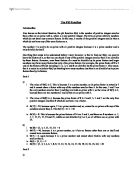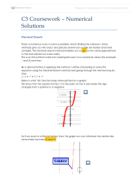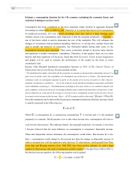numerical solutions-Comparison of the three methods and Newton Raphson
Numerical Solutions of equations ) Newton Raphson method Equation to be solved is x³-5x-1=0 The function f(x)= x³-5x-1is shown below There are 3 roots. I will first find the root in the interval [2, 3] I will do the first few lines of calculation manually. The formula to use is: xn+1= xn -f(xn)/ f'(xn) Therefore I must first differentiate x³-5x-1 which is 3x2-5 Using x1=3 X2: 3 - [(33-5 x 3-1)/(3 x 32 -5)] = 2.5 X3: 2.5 - [(2.53-5 x 2.5-1)/(3 x 2.52 -5)] = 2.3455 I will now work out all 3 roots using autograph until 5 significant figures are guaranteed The 3 boxes above show how I obtained the 3 roots of the equation x³-5x-1=0 Which are -0.20164, -2.1284 and 2.3301 Below is the function f(x)= x³-5x-1 showing where I applied the Newton's Raphsons to find each root, showing the tangent made to the curve and how it converges closer each time. I will now illustrate one of these roots graphically, showing closely the changes in the tangent to the curve. I will use the root in interval [2, 3] Error bounds for interval [2, 3] 2.3301 is the root in this interval to 5 significant figures. Therefore the error is 2.3301 ± 0.00005 I will now perform the change of sign test to confirm it is within these limits. Lower limit is 2.33005 then f (2.33005) = -0.000098648 Upper limit is 2.33015 then f (2.33015) = 0.0010302 There is a change of sign
Investigation of the Phi Function
The Phi Function Introduction Also known as the totient function, the phi function ?(n) is the number of positive integers smaller than n that are co-prime with n, where n is any positive integer. The term co-prime refers to numbers which do not share any common factors. In this case, it means all the positive integers smaller than n which do not have any of the same factors as n. The number 1 is said to be co-prime with all positive integers because it is a prime number and is only divisible by itself. One thing that needs to be understood before I start, however, is that to find out ?(n), we need to know the factors of n, so that we can check if any of the positive integers smaller than it are divisible by those factors. However, even these factors of n must be divisible by its prime factors and larger numbers may have many factors but only a few prime factors. For example, the prime factor of 8 is 2 and all the factors of 8 (not including 1) i.e. 2, 4, and 8 are divisible by the prime factor 2. This means that it is easier to calculate ?(n) by checking how many numbers less than n are divisible by its prime factors than by its factors. Part 1 a) i The value of ?(3) is 2. This is because 3 is a prime number, so its prime factor is naturally 3 and it cannot share a factor with any of the numbers smaller than it. In this case, 1 and 2 are the only numbers smaller than
Triminoes Investigation
Triminoes Investigation Sequences There are different lots of sequences such as Arithmetic progressions, Geometric progressions and other sequences. There are many types of sequences, sequences that increase by a fixed amount between each term are known as arithmetic progressions or arithmetic series. Odd and even numbers both increase by two from one term to the next. The multiples of seven increases by seven, from one term to the next. Arithmetic progressions There are many types of sequences, sequences that increase by a fixed amount between each term are known as arithmetic progressions or arithmetic series. Odd and even numbers both increase by two from one term to the next. The multiples of seven increases by seven from one term to the next. Odd numbers 1, 3, 5, 7, 9, ... Even numbers 2, 4, 6, 8, 10, ... Multiples of seven 7, 14, 21, 28, ... are examples of arithmetic progressions or arithmetic series. Geometric progressions Geometric progressions or geometric series are sequences in which successive terms are in the same ratio. To get the next power of two you simply double the previous value. In the example of exponential growth the next term is obtained by multiplying the previous term by 1.5. Powers of two 1, 2, 4, 8, 16, ... Exponential growth 10, 15, 22.5, 33.75, ... Exponential decay 20, 16, 12.8, 10.24, 8.192, ... are
To apply various numerical methods to find roots of equations and to appreciate the limitations of these methods
Maths Coursework Jonathan Nye The aim of this assignment is to... Be able to apply various numerical methods to find roots of equations and to appreciate the limitations of these methods; Know some techniques which I will find useful in other areas of mathematics and in other subjects; Understand some of the key ideas underlying numerical analysis, a branch of mathematics in its own right. In this coursework I am going to investigate ways of solving equations of a graph using a number of methods. The first equation I have chosen to investigate is 'y=2x³+5x²+x-1' and I am going to investigate the solutions of this equation using decimal search. Bellow is a copy of the table y=f(x) for a range of values. To find one of the roots of the equation I am going to use the decimal search method to three significant figures. X= Ans -4 -53 -3 -13 -2 -1 0 -1 7 2 37 3 01 4 211 There are three changes of sign in the table above, which correspond to the three changes of roots on the graph. I am going to prove this is the case for the change in sign between y=0 and y=1 As can be seen from the table below, when focussed down to one decimal place, the sign change lies between 0.3 and 0.4. This shows that the root I am trying to find lies between these two values. X= Ans 0 -1 0.1 -0.848 0.2 -0.584 0.3 -0.196 0.4 0.328 0.5 0.6 .832 0.7 2.836 0.8
The Rational Zeros
IB Higher Level Mathematics Project Roberto Thais The Rational Zeros . a) Graph in turn the following functions (take and ): (i) We find that the roots are: Therefore, the smallest positive root, expressed as a fraction is (ii) We find that the roots are: Therefore, the smallest positive root, expressed as a fraction is (iii) We find that the roots are: Therefore, the smallest positive root, expressed as a fraction is (iv) We find that the roots are: Therefore, the smallest positive root, expressed as a fraction is From these functions we can notice that the denominator of the x value at 0 of the smallest positive root is always the same as the first coefficient of the polynomial. While the second and fourth terms of the polynomials are kept constant, so does the numerator and the other two roots of the function keep constant. b) Now graph and find the smallest positive root of , and express it as a fraction. Also find the other roots. We find that the roots are: Therefore, the smallest positive root, expressed as a fraction is The same principle as that seen before is observed in this curve which has fractional coefficients: the denominator is equal to the first coefficient and the numerator is equal to 1 as the second and fourth terms are kept constant. Simplifying the expression we get
Solutions of equations
C3 Solutions of equations By Gareth Brown Introduction I will be investigating the solutions of equations using the following three methods: . Change of sign method 2. Newton-Raphson method 3. Fixed point iteration after rearranging the equation from form f(x) =0 into the form x = g(x) I will solve the equations with these methods as I cannot solve them by any algebra I have met so far. The equations I am going to use are the following: * y = 243x3-378x2+192x-32 = 0 * y = ex-x3-1.4 = 0 * y = 43x3-60x2-250x-115 = 0 * y = x3-5x+2.6 = 0 In my investigation I will give illustrated examples of the methods failing for the root I am looking for. All failures will be explained. In my investigation I will use a Casio calculator to help draw graphs and to help identify where the rots are. I will also have computer software such as Autograph to help draw graphs and to show certain methods graphically. Change of Sign Method I will be using the "decimal search" method to check for a change of sign in the equation: y = 243x3-378x2+192x-32 The graph of this function is given below. I then decided to confirm the shape of the graph by finding how many turning points there is. Dy = 729x2-756x+192 = 0 Dx Quadratic Equation: D= b2-4ac =-7562-(4*729*192) =11664 > 0 => 2 Real Turning Points (Graph Shape Confirmed) By putting in Values of X into the equation I found some
Investigate the number of winning lines in the game of connect 4.
Investigation Connect 4 X X X X Task This is a winning line in the game of connect 4 on a 4x5 board. Winning lines can be horizontal, vertical and diagonal. Investigate the number of winning lines in the game of connect 4. The task is asking me to find out how many winning lines (connects) when you are connecting 4 there are on any size board. What am I going to do •I am going to find out how many connect 4 there are in a 4x5 board. •I will change the size of the box, but keep one value the width constant. And I will find a pattern in the number of connects there are in the different size boxes. •I will use algebra to find a general formula for a NxWidth (W) box. •I will then increase the width (constant) by one and work out a formula for that box. •I will then find a pattern in the formulas for the different size boxes, connecting 4, and I will make a formula for the formula. •I will then change the number that I will connect. For example 2, 3 or 5. Connect 4 Firstly I will do a box with the width constant as 5 and I will change the height. Hx5 Box Any Number=N Connects=C Height= H Width =W Hx5 1 2 3 4 5 6 Connects 2 4 6 17 28 39 first layer 11 11 11 second layer The box height of 1 and 2 do follow the pattern so they are
Pure Mathematics - In this coursework, I will be investigating and comparing the use of 3 different numerical methods for finding roots of equations.
Pure Mathematics 2 Coursework Introduction In this coursework, I will be investigating and comparing the use of 3 different numerical methods for finding roots of equations. The numerical methods that I will be using for this coursework are as follows: . Change of sign: Decimal search 2. Fixed point iteration: Newton-Raphson Method 3. Rearranging f(x)=0 to the form x=g(x) Change of Sign: Decimal Search For this method I will be using the above equation: x³-4x²-3x+5=0. The first step for this method is to construct a table of values that range the values of the x-axis that the graph passes: x F(x) -5 -205 -4 -111 -3 -49 -2 -13 -1 3 0 5 -1 2 -9 3 -13 4 -7 5 5 F(x) changes sign between [-2,-1], [0,1] and [4,5]; indicating that a root lies between each of these x co-ordinates. The next few steps can now be repeated to obtain a more accurate value, taking x1 and x2 to be the lower and upper possible bounds of x. I shall be testing x between 4 and 5. The table below gives the corresponding y-values for the f(x) values between x1=4 and x2=5. From this, it can be seen that a root lies between x=4 and x=5. x F(x) 4.0 -7 4.1 -5.61967 4.2 -4.07234 4.3 -2.35343 4.4 -0.45665 4.5 .62554 4.6 3.89644 4.7 6.36388 4.8 9.03272 4.9 1.90922 5.0 5 The new values of x would be x1=4.4 and x2=4.5. These steps can be repeated to a necessary
Number pyramids
Number pyramids Plan I am trying to investigate a formula, so that I can calculate the base for small number pyramids, for example the base numbers of a pyramid 1, 2,3 etc. By the end of this I should be able to use that formula to calculate any amount of numbers used for the base of pyramids. Challenge The challenge is whether you can predict the finishing number for a pyramid, which has 17 numbers along the base and starts with 23. This challenge has to be carried out without guessing or drawing the actual number pyramids. What is a number pyramid? 8 3 5 1 2 3 A number pyramid is basically adding the two consecutive numbers at the bottom in order to get the second row of numbers. Then you would add those two numbers to get the top number. So therefore it is essentially adding continuously in order to get the numbers above. Method 16 20 24 28 7 9 9 11 11 13 13 15 3 4 5 4 5 6 5 6 7 6 7 8 You will be able to notice that by looking at 3 numbers at the base, the first row has a difference of 1, the middle number goes up by 2 and the top number goes up by 4. So therefore you would multiply the middle base number by 4, in order to get the top number. First Number Last Number Top Number 3 8 2 4 2 3 5 6 4 6 20 5 7 24 Once I have put the results in a table, I can analyse
Information Technology Development Cycle Diary
The Diary 9/02/2002 Today I set up the input, process and invoice screen according to the hand drawn plan and the functions and calculations according to "The Workbook" section. I did not set-up any validation checks, macros or cell protection. I simply wanted to see if this section of the system would function correctly. Input Process Problem On the process sheet I had difficulty setting up the 'Discount on spending' cell. I used the formulae: =IF(G21>300,40,G21>200,20,G21>100,10,0) However this formula would not work and error messages came up. After looking at Microsoft help I realised my mistake. After the "Otherwise" comma in the formula another if function has to be used. So the corrected formula is =IF(G21>300,40,IF(G21>200,20,IF(G21>100,10,0))) Invoice Problem If room selection 2 was left blank on the input screen then the invoice looked as follows If there is only one room ordered I wanted the second row of the invoice table to be blank. To do this I added an IF function in front of the formulas in the cells. So the formulas changed (see next page). This meant if only one room was ordered the second row of the invoice table would be















